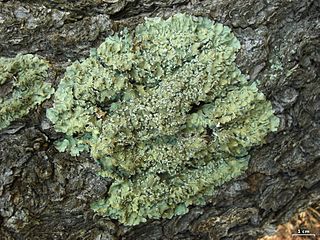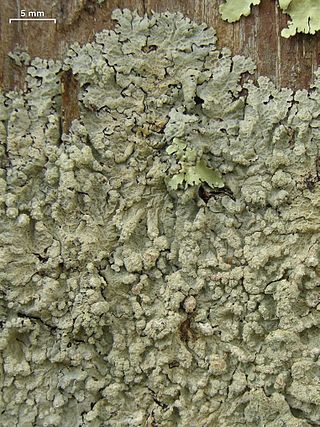
The Parmeliaceae is a large and diverse family of Lecanoromycetes. With over 2700 species in 71 genera, it is the largest family of lichen-forming fungi. The most speciose genera in the family are the well-known groups: Xanthoparmelia, Usnea, Parmotrema, and Hypotrachyna.

Pyxine is a genus of foliose lichens in the family Caliciaceae. The genus has a widespread distribution in tropical regions.

Myelochroa is a genus of foliose lichens in the family Parmeliaceae. They are commonly known as axil-bristle lichens. It was created in 1987 to contain species formerly placed in genus Parmelina that had a yellow-orange medulla due to the presence of secalonic acids. Characteristics of the genus include tightly attached thalli with narrow lobes, cilia on the axils, and a rhizinate black lower surface. Chemical characteristics are the production of zeorin and related triterpenoids in the medulla. Myelochroa contains about 30 species, most of which grow on bark. The genus has centres of distribution in Asia and North America.

Flavopunctelia is a genus of foliose lichens in the family Parmeliaceae. The genus contains species that are widespread in temperate and tropical areas. The genus is characterised by broad, yellow-green lobes, point-like (punctiform) pseudocyphellae on the thallus surface, and bifusiform conidia. All species contain usnic acid as a major secondary chemical in the cortex. Flavopunctelia was originally conceived as a subgenus of Punctelia by Hildur Krog in 1982; Mason Hale promoted it to generic status in 1984.

Flavoparmelia is a genus of foliose lichens in the family Parmeliaceae. Because of their appearance, they are commonly known as greenshield lichens. The widely distributed genus contains 32 species. It was circumscribed by American lichenologist Mason Hale in 1986 to contain 17 former Pseudoparmelia species with broad lobes, usnic acid in the cortex, and isolichenan in the cell walls.

Bulbothrix is a genus of lichen-forming fungi in the family Parmeliaceae. This genus is synonymous with Bulbothricella V.Marcano, S.Mohali & A.Morales. Bulbothrix was circumscribed by lichenologist Mason E. Hale in 1974 with Bulbothrix semilunata as the type species.

Parmelinella is a genus of lichen belonging to the family Parmeliaceae. The genus was circumscribed in 1987 by John Elix and Mason Hale as a segregate of Parmelina, from which it differs in having larger ascospores and containing salazinic acid. Although the genus had been assumed to be well-defined morphologically, a 2021 molecular phylogenetic study suggests that the generic delimitations need to be revised.

Punctelia is a genus of foliose lichens belonging to the large family Parmeliaceae. The genus, which contains about 50 species, was segregated from genus Parmelia in 1982. Characteristics that define Punctelia include the presence of hook-like to thread-like conidia, simple rhizines, and point-like pseudocyphellae. It is this last feature that is alluded to in the vernacular names speckled shield lichens or speckleback lichens.

Relicina is a genus of foliose lichens belonging to the large family Parmeliaceae. It contains 59 species.

Imshaugia is a genus of seven species of foliose lichens in the family Parmeliaceae. They are commonly known as starburst lichens.
Parmotremopsis is a genus of lichen-forming fungi in the family Parmeliaceae. The genus was circumscribed in 1987 by lichenologists John Elix and Mason Hale.

Crespoa is a genus of five species of lichen in the family Parmeliaceae. Species in this genus are characterized by having an upper thallus surface that is wrinkled and reticulately ridged to coarsely foveolate.
Bulbothrix meizospora is a species of foliose lichen in the family Parmeliaceae. It is found in Africa, Asia, and South America, where it grows on tree bark.
Punctelia nashii is a species of foliose lichen in the family Parmeliaceae. It is known only from California.
Bulbothrix thomasiana is a species of foliose lichen in the family Parmeliaceae. It is a corticolous species that grows on tree trunks in the northern and central parts of South America. The lichen was formally described as a new species in 2011 by lichenologists Michel Benatti and Marcelo Marcelli. The specific epithet honours American lichenologist Thomas Hawkes Nash III.
Canoparmelia consanguinea is a species of saxicolous (rock-dwelling), foliose lichen in the family Parmeliaceae. Found in Brazil, it was formally described as a new species in 2009 by lichenologists Marcelo Marcelli, Luciana da Silva Canêz, and John Elix. The type specimen was collected from an open field in Fazenda da Estrela at an altitude of 920 m (3,020 ft), where it was growing on basaltic rock.
Canoparmelia roseoreagens is a species of corticolous (bark-dwelling), foliose lichen in the family Parmeliaceae. Found in Brazil, it was formally described as a new species in 2009 by lichenologists Marcelo Marcelli, Luciana da Silva Canêz, and John Elix. The type specimen was collected from a Brazilian pine forest in Fazenda da Estrela at an altitude of 905 m (2,969 ft), where it was found growing on tree bark.
Canoparmelia subroseoreagens is a species of foliose lichen in the family Parmeliaceae. Found in Brazil, it was formally described as a new species in 2009 by lichenologists Marcelo Marcelli, Luciana da Silva Canêz, and John Elix. The type specimen was collected from a Brazilian pine forest in Fazenda da Estrela at an altitude of 905 m (2,969 ft), where it was found growing on tree bark. The lichen is named for its similarity to Canoparmelia roseoreagens but that species produces isidia rather than soredia.












